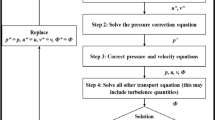Abstract
At present, there are still some controversial considerations on the closing mechanism of natural heart valves. In this area a lot of phenomena still remain mysterious. particularly for the mechanism of earlier partial closure of the valve while the blood ejection is still in its acceleration phase. It is the purpose of this study to focus on the problem of carlier closure mechanism of heart valves by using both theoretical analysis and expermental verifications. A certain two-dimensional mathematical model of closure with all contributing factors and the whole operating process being considered is investigated with a new analytical method. Several new conclusions were found. The main points are as follows:
-
1.
During the opening phase, the main factor of motion of the valve, is the accelerating flow. and the decelerating flow plays a main role during most the of time of the deceleration phase. But during the quasi-steady phase of blood ejection. it is the vortex in the sinus that controls the valve closure.
-
2.
For the carlier partial closure of the valve during the acceleration phase. the vortex is a decisive factor, but its function is limited. It is found in the same time that without the vortex. the valve can still close in a similar manner. but there will be no carlier closure during the acceleration phase which characterizes the situation of being with vortex.
-
3.
It is ascertained that the existence of the sinus is essential to the effective closure of the valve.
In addition, the effects of the valve length. frequency and peak flow rate of the motion of the valve are studied in this paper. Such studies are useful for the design of artificial heart valves.
Similar content being viewed by others
References
Belhouse, B. J., et al, The fluid mechanics of the aortic valve.J. Fluid Mech.,35, 4 (1969), 721–735.
Van Steenhoven, A. A., et al, Model studies of the closing behavior of the aortic valve,J. Fluid. Mech.,90, 1 (1979), 21–32.
Van Steenhovne, A. A., et al, The effect of some hemodynamic factors on the behavior of the aortic valve,J. Biomech.,15, 42 (1982), 941–950.
Reul, H., et al, Fluid mechanics of the natural, mitral valve.J. Biomech.,14, 5 (1981), 361–372.
Peskin, C. S., The fluid dynamics of heart valves: experimental, theoretical and computational methods,Ann. Rev. Fluid Mech.,14 (1982), 235–259.
Bellhouse, B. J., Velocity and pressure distributions in the aortic valve.J. Fluid Mech.,37, 3 (1969), 587–600.
Tuck, E. O., et, al Cambered valve leaflets that maximize initial rate of closure.J. Fluid Mech. 121, (1982), 517–529.
Author information
Authors and Affiliations
Rights and permissions
About this article
Cite this article
Ming, L., Zhen-huang, K. Study of the closing mechanism of natural heart valves. Appl Math Mech 7, 955–964 (1986). https://doi.org/10.1007/BF01907597
Received:
Issue Date:
DOI: https://doi.org/10.1007/BF01907597




